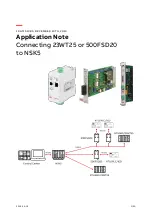
15 Basics
184
operation. The original
SCS
-PTC uses a real analogue memory ARQ, whereby the
received AF tone is not simply turned into 0 or 1 data, but intermediate values are also
stored. Therefore a more fine-tuned analysis is possible than with so-called "digital
memory ARQ".
15.2
Why PACTOR-2?
PACTOR Level I has established itself, in the last few years, as the new standard for FSK
radio teletype on HF links. With PACTOR-1 it was possible, for the first time, to utilize
the possibilities of an almost ideal combination of simple FSK modulation combined with
an ARQ protocol nearly perfect. Even now, PACTOR-I, with analogue memory ARQ,
has shown itself to be the most robust, narrow band radio teletype system available using
FSK modulation, though another relatively similar FSK ARQ protocol has recently been
developed.
In the meantime, the signal processor technology (DSP) has reached a stage where the
implementation of high performance modems with a reasonable price to performance
ratio is possible, and because of this it becomes interesting for the radio amateurs and?
now a requirement - as with the development of the PACTOR-1 protocol about 8 years
ago - for a radio teletype system which takes maximum advantage of the possibilities
offered by modern hardware, and which can be classed as "state of the art".
The main question was, what could be improved in PACTOR-1. A bit of head scratching
provided the answer. First of all a significant improvement has to be done to the working
range, which requires greater adaptability. In practice this means that even extremely
weak or disturbed signals should still allow a connection, even if they are so bad that
PACTOR-1 can no longer transfer data. On the other hand, observations have shown that
PACTOR-1 links often work at 200 baud, virtually without repetitions, on the higher
bands. In any case, the effective information speed (when required, i.e. when data is
really available) should be increased, so that data is transferred as fast as propagation will
allow.
For a new protocol the following conditions of compatibility should be observed:
4.
All advantages of the
old
protocol should be obtained.
•
Step synchronous ARQ protocol.
•
Simple half-duplex operation with short packets during a direct QSO (high
spontaneity
)
•
Full data transparency (binary, ASCII, Huffman, Markow, etc.).
•
Full support of analogue memory ARQ.
•
Should be able to connect under poor S/N ratio conditions, and with a short phasing
time. (no requirement for a valid CRC to connect, therefore short pause times for
scanning BBS).
•
Independence from sideband selection (no mark/space convention or similar
limitations).
•
Free choice for the center frequency of the audio signal in a range between 400 Hz
and 2600 Hz.















































